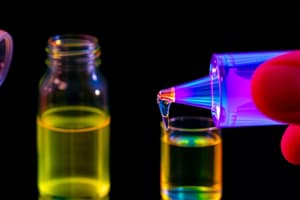Podcast
Questions and Answers
What is the difference between UV-Vis and IR spectroscopy in terms of what they measure in molecules?
What is the difference between UV-Vis and IR spectroscopy in terms of what they measure in molecules?
UV-Vis spectroscopy measures the absorption of energy by electrons in molecules causing transitions to higher energy levels, while IR spectroscopy measures the absorption of energy by molecular vibrations.
What does the acronym 'm/z' represent in a mass spectrum, and what is its significance?
What does the acronym 'm/z' represent in a mass spectrum, and what is its significance?
The acronym 'm/z' represents the mass-to-charge ratio of an ion. It is a key parameter in mass spectrometry, as it allows for the identification and characterization of ions based on their mass and charge.
Explain the significance of the (M+1) peak in a mass spectrum, and explain its origin.
Explain the significance of the (M+1) peak in a mass spectrum, and explain its origin.
The (M+1) peak represents the presence of a heavier isotope of the molecule, usually due to the incorporation of Carbon-13 instead of Carbon-12. It provides information about the isotopic composition of the molecule.
What is the base peak in a mass spectrum and why is it important?
What is the base peak in a mass spectrum and why is it important?
Outline the main steps involved in obtaining a mass spectrum of an organic compound.
Outline the main steps involved in obtaining a mass spectrum of an organic compound.
How does mass spectrometry differ from other spectroscopic techniques like UV-Vis and IR spectroscopy?
How does mass spectrometry differ from other spectroscopic techniques like UV-Vis and IR spectroscopy?
Describe two key applications of mass spectrometry in scientific research and analysis.
Describe two key applications of mass spectrometry in scientific research and analysis.
Why are neutral particles not detected in mass spectrometry?
Why are neutral particles not detected in mass spectrometry?
What are the advantages of using mass spectrometry for the structural characterization of unknown compounds?
What are the advantages of using mass spectrometry for the structural characterization of unknown compounds?
Explain how mass spectrometry can be used to distinguish between molecules of similar relative molecular mass.
Explain how mass spectrometry can be used to distinguish between molecules of similar relative molecular mass.
What is the role of the heated cathode in a mass spectrometer?
What is the role of the heated cathode in a mass spectrometer?
What does the mass-to-charge ratio (m/z) of an ion indicate in a mass spectrum?
What does the mass-to-charge ratio (m/z) of an ion indicate in a mass spectrum?
Describe the process of ionization in a mass spectrometer. What type of ions are typically produced?
Describe the process of ionization in a mass spectrometer. What type of ions are typically produced?
What technique is commonly used for ionization in mass spectrometry, and how does it work?
What technique is commonly used for ionization in mass spectrometry, and how does it work?
What are the major stages of the mass spectrometry process? Briefly describe each stage.
What are the major stages of the mass spectrometry process? Briefly describe each stage.
What is the purpose of the magnetic field in a mass spectrometer?
What is the purpose of the magnetic field in a mass spectrometer?
Explain how fragmentation contributes to the formation of a mass spectrum.
Explain how fragmentation contributes to the formation of a mass spectrum.
What type of ions are typically detected in a mass spectrum, and why? Explain the relevance of the charge.
What type of ions are typically detected in a mass spectrum, and why? Explain the relevance of the charge.
Describe the difference between a radical cation and a regular cation.
Describe the difference between a radical cation and a regular cation.
Explain how the abundance of each ion in a mass spectrum is displayed and what information it provides about the molecule.
Explain how the abundance of each ion in a mass spectrum is displayed and what information it provides about the molecule.
Explain the difference between the molecular ion peak (M) and the base peak in a mass spectrum.
Explain the difference between the molecular ion peak (M) and the base peak in a mass spectrum.
What causes the M+1 peak in a mass spectrum?
What causes the M+1 peak in a mass spectrum?
Describe the role of isotopes in identifying a compound using mass spectrometry.
Describe the role of isotopes in identifying a compound using mass spectrometry.
Explain how the stability of carbocations affects the peaks observed in a mass spectrum.
Explain how the stability of carbocations affects the peaks observed in a mass spectrum.
Explain why the molecular ion peak of 2-methylbutan-2-ol is absent in its mass spectrum while it's present in the mass spectrum of its isomer, pentan-2-ol.
Explain why the molecular ion peak of 2-methylbutan-2-ol is absent in its mass spectrum while it's present in the mass spectrum of its isomer, pentan-2-ol.
List five applications of mass spectrometry.
List five applications of mass spectrometry.
Briefly describe how a mass spectrometer works and how it obtains the mass spectrum of a molecule.
Briefly describe how a mass spectrometer works and how it obtains the mass spectrum of a molecule.
Explain the significance of the molecular ion peak in a mass spectrum.
Explain the significance of the molecular ion peak in a mass spectrum.
What is the purpose of fragmenting molecules in mass spectrometry?
What is the purpose of fragmenting molecules in mass spectrometry?
Describe how mass spectrometry can be used to identify a compound based on its fragmentation patterns.
Describe how mass spectrometry can be used to identify a compound based on its fragmentation patterns.
Flashcards
UV-visible spectroscopy
UV-visible spectroscopy
Analyzes absorption of UV and visible light causing electron excitation in molecules.
Infrared spectroscopy
Infrared spectroscopy
Involves absorption of IR light causing molecular vibrations in covalent bonds.
Mass Spectrometry
Mass Spectrometry
An analytical technique to determine molecular weights and identify substances without radiation.
Ionization
Ionization
Signup and view all the flashcards
Mass-to-charge ratio (m/z)
Mass-to-charge ratio (m/z)
Signup and view all the flashcards
Base peak
Base peak
Signup and view all the flashcards
(M+1) peak
(M+1) peak
Signup and view all the flashcards
Relative abundance
Relative abundance
Signup and view all the flashcards
Electron ionization
Electron ionization
Signup and view all the flashcards
Neutral particles
Neutral particles
Signup and view all the flashcards
Molecular Ion Peak (M)
Molecular Ion Peak (M)
Signup and view all the flashcards
Fragment Ion
Fragment Ion
Signup and view all the flashcards
Isotopic Abundance
Isotopic Abundance
Signup and view all the flashcards
Stable Carbocations
Stable Carbocations
Signup and view all the flashcards
Relative Molecular Mass
Relative Molecular Mass
Signup and view all the flashcards
Mass Spectrum
Mass Spectrum
Signup and view all the flashcards
Applications of Mass Spectroscopy
Applications of Mass Spectroscopy
Signup and view all the flashcards
Methyl Bromide Isotopes
Methyl Bromide Isotopes
Signup and view all the flashcards
Molecular Ion
Molecular Ion
Signup and view all the flashcards
Mass-to-charge Ratio
Mass-to-charge Ratio
Signup and view all the flashcards
Acceleration
Acceleration
Signup and view all the flashcards
Deflection
Deflection
Signup and view all the flashcards
Electron Impact Ionization
Electron Impact Ionization
Signup and view all the flashcards
Radical Cation
Radical Cation
Signup and view all the flashcards
Detector in Mass Spectrometry
Detector in Mass Spectrometry
Signup and view all the flashcards
Study Notes
UV-Visible Spectroscopy
- Absorption in the UV and visible regions of the electromagnetic spectrum causes electrons in atoms and molecules to move to higher energy levels.
Infrared Spectroscopy
- Covalent bonds vibrate with frequencies corresponding to frequencies in the infrared range of the electromagnetic spectrum.
- When molecules are irradiated with IR light, they absorb energy and the amplitude of the vibrations increases.
Mass Spectrometry
- Mass spectrometry is a powerful analytical technique that does not use electromagnetic radiation.
- This technique is used for determining molecular weights, characterizing unknown compounds, identifying components in mixtures and studying gas-phase reactions.
Basic Principles (Mass Spectrometry)
- A mass spectrum is created by exciting an atom or molecule in the gas phase with enough energy to cause ionization.
- The formed gaseous ions are usually positively charged (+1).
- The mass-to-charge ratio (m/z) and the relative abundance of each gaseous ion are displayed on a horizontal axis.
Further Details (Mass Spectrometry)
- The x-axis units are atomic mass units divided by the charge on the ion (usually +1).
- The y-axis of the spectrum displays the percentage relative abundance.
- The strongest peak (base peak) is assigned a value of 100% relative abundance.
- The other ions' percentages are quoted relative to the base peak.
- Only cations are detected.
Obtaining a Mass Spectrum
- The first step in mass spectrometric analysis of compounds is to produce gas-phase ions from the compound (commonly by electron ionization).
- The initial molecular ion undergoes fragmentation.
- Each primary product ion further fragments.
- Ions are separated in the spectrometer based on their mass-to-charge ratio and detected in proportion to their abundance.
- The mass spectrum is a plot of ion abundance versus mass-to-charge ratio.
Analysis (Mass Spectrometry)
- The tallest peak in the mass spectrum corresponding to the fragment with the greatest abundance is known as the base peak.
- The heaviest ion from the complete molecule losing an electron is called the molecular ion peak (M).
- A peak with a mass 1 unit heavier than the molecular ion peak is referred to as the M+1 peak.
- The M+1 peak is often due to the presence of 13C or 2H isotopes in molecules.
Characteristic Peaks (Mass Spectrometry)
- The fragment in greatest abundance produces the tallest peak (base peak).
- The peak produced by the heaviest ion when an electron is lost from the molecule is called the Molecular Ion Peak (M).
- A peak with mass 1 unit heavier than the molecular ion peak is the M+1 peak.
Applications of Mass Spectroscopy
- Determining relative isotopic masses and relative abundance.
- Distinguishing between molecules of similar relative molecular mass.
- Identifying compounds based on fragmentation patterns.
- Used in carbon and other radioactive dating processes, satellite analysis, forensic science, drug testing, and process monitoring in industries (petroleum, chemical and pharmaceutical).
Additional Notes (Mass Spectrometry)
- Mass spectrometry differs from other spectroscopic techniques as it does not utilize electromagnetic radiation, but rather ionizes molecules to determine their structure.
- A mass spectrometer separates ions based on their mass-to-charge ratio.
- The base peak is used as a standard to compare the abundance of other fragments.
- The molecular ion peak corresponds to the original molecule.
- The M+1 peak helps to identify the presence of 13C or 2H isotopes.
Electron Impact Ionization
- A high-energy electron can dislodge an electron from a bond, creating a radical cation(a positive ion with an unpaired electron).
- Only cations are detected.
Studying That Suits You
Use AI to generate personalized quizzes and flashcards to suit your learning preferences.




